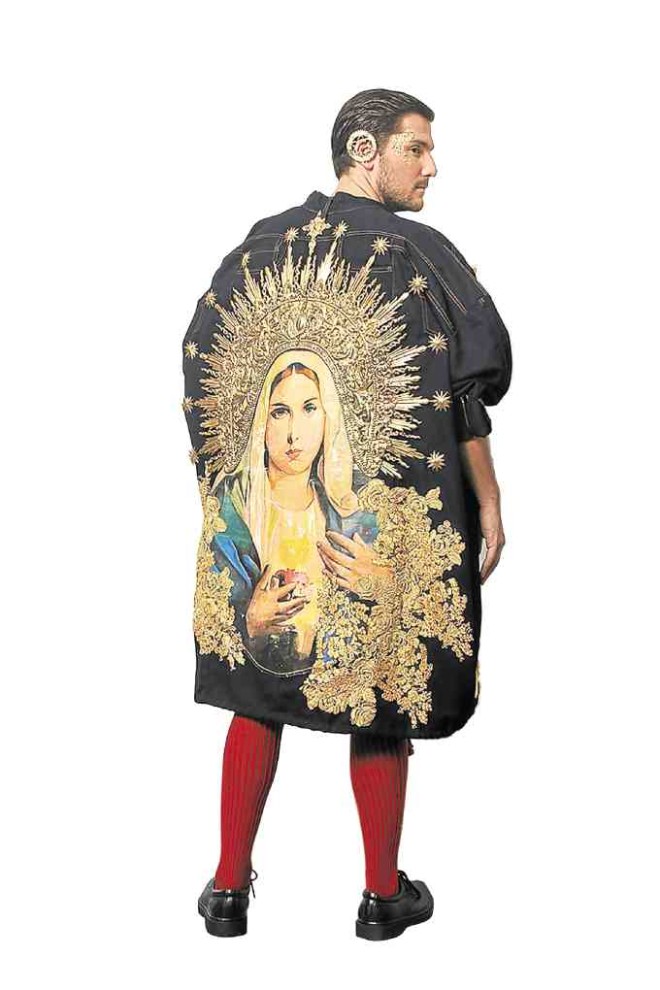
lends a three-dimensional effect. —PHOTOS BY NELSON MATAWARAN
After seasons of minimalism, maximalism is making a comeback. And no one’s happier than Luis Romero Ablaza III, or Jun Jun to friends.
Ablaza is known for styling special events and producing costume jewelry and wearable art that are sold at his store, Ablaze, at Market! Market! His birthday parties have always been over-the-top photo exhibits of hot, half-naked models sporting his accessories in fantasy settings.
This year, Ablaza presented his first-ever fashion show at the family estate, Amelia, in Alfonso, Cavite. Early guests entertained themselves at the souk outside the pavilion, where four-poster brass beds and stalls displayed Ablaza’s accessories. People snapped up the ear curves and obis. Meanwhile, the pavilion, the fashion show venue, was fully decked with kimonos that could clothe two barangay.
Idiosyncratic collection
Ablaza’s idiosyncratic fashion collection chronicles his travels, his religious devotion and his closeness to his mother, Amelia “Mellie” Ablaza, a lawyer and one of Manila’s top hostesses.
His close friends, designers Michele Sison and Steve de Leon, and stylist Roko Arceo, collaborated with him to produce a 52-piece collection of wearable art. For six months, Arceo and Ablaza scoured high-street stores and bought marked-down denims in bulk.
Sison and her atelier deconstructed the skirts, pants, shorts and jackets into ponchos, oversized coats, caftans, robes, coat-tails and men’s sarongs.
by Steve de Leon that matches her Dolce & Gabbana shoes.
Husband Louie sports a denim suit by R.M. Manlapat
It took six or seven deconstructed denims to make one coat. One jacket had sleeves made from 20 denim waistbands. All of these became canvases for Ablaza’s mementoes, purses and artworks that were piled up into collages.
The collection was divided into continents—Asia, Europe, Africa, North and Latin America. It opened with an ankle-length Ifugao vest composed of strips of denim and ikat fabric, woven cords and native seeds.
The long vest representing the Visayas had appliquéd fish patterns, mother-of-pearl crescents and black corals, while the Mindanao jacket was adorned with gilt tamburin and mini gongs.
Jackets in the Asian suite featured Indonesian goatskin shadow puppets, quilted images of Buddha and elephants from Thailand, and kabuki masks and obi sashes from Japan. To make one denim kimono top, Sison’s atelier cut up eight pairs of denim pants and sewed koi, lanterns, geisha patterns, fabric purses and tassels.
Funky versions
Belly-dancing belts and embroidered Rajasthani pillowcases went into the Indian jacket. The Korean jackets were funky versions of K-pop fashion.
De Leon made use of Ablaza’s collection of Maasai beads, dowry beads, glass and seeds and python skin to make African masks on the backs of denim caftans.
Then there was the Brazilian vest with feathers, rhinestones and crystals that evoked the Carnivale theme. America was represented by
Arceo
bomber jackets with red, white and blue patches and stars and stripes.
The European collection was the most opulent. The jackets were sewn with actual paintings on soft canvas, along with needlepoint tapestry, jeweled crosses and repoussé—ornamental metalwork in religious art. De Leon depicted the Parisian lifestyle with an appliqué of a woman walking her bulldog, plus Mellie’s feathered purses.
In every collection, Ablaza would show his religious side. He portrayed Italy with images of the Blessed Virgin and the Infant Jesus, decorated with metal reliefs. The finale was a men’s sarong filled with bejeweled gold pendants, brooches, pins, medallions and crucifixes.
Quite an experience
Ablaza wore a denim waistcoat replete with coattails, encrusted with his mother’s diamond chandelier earrings and necklaces and gleaming pearls. The jewelry was sewn at his residence under his watchful eyes.
“Jun Jun is a hoarder. Everywhere he goes, he buys what he likes so he can make tablescapes or accessories,” said Sison. “It was quite an experience for my sewers and beaders to deconstruct the denims and sew home décor on them,” said Sison.
We asked a hunky model if he would wear those clothes. “Maybe to a fashion show,” he replied.
Sison added, “Some designers make clothes with a person in mind. Others design clothing in the way they would wear it. That’s Jun Jun. It takes another person who thinks like Jun Jun to wear his creations.”—CONTRIBUTED
pins
geisha appliqués and cutesy stuff
from his mother’s collection. The ear curve caps the look.